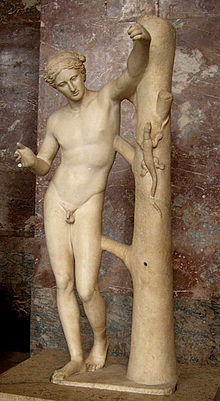Apollo Sauroctonos

Apollo Sauroktonos (Apollo Lizard-killer) is the title of several 1st - 2nd century AD Roman marble copies of an original by the ancient Greek sculptor Praxiteles. The statues depict a nude adolescent Apollo about to catch a lizard climbing up a tree. Copies are included in the collections of the Louvre Museum, the Vatican Museums, and the National Museums Liverpool.
The Original
The bronze original of this sculpture is attributed by Pliny (XXXIV, 69-70) to the Athenian sculptor Praxiteles and is usually dated to c.350-340 BC. Martial wrote an epigram about the statue (14, 172): "Spare, treacherous child, the lizard which is crawling towards you. It is eager to perish by your hands."[1]
The Cleveland Museum of Art claims to own a bronze original (or part-original) of this work. The work is currently being analyzed to verify this claim by scholars and archaeologists. Greece has raised questions about ownership and title.[2][3]
Iconography
The statue's iconography could indirectly refer to Apollo's fight against the serpent Python or, if the lizard is an attribute of the god, it could show Apollo in his purifying function, as a destroyer of plagues; Greek gods called smintheus (rat-killer) or parnopios (grasshopper-killer) are certainly known.[citation needed]
Roman popular representations

Small-scale decorative reproductions were made in the Roman era. The theme of Apollo and the lizard is also found on Roman mosaics.
The Louvre version
The Louvre version is 1.49 metres (4.9 ft) high, as Inventaire MR 78 (n° usuel Ma 441), and the left arm, the right hand and the lizard's head are modern restorations. Formerly in the Borghese collection, it was bought by Napoleon in 1807.
Notes
- ^ Valerius Martialis. "Martial, Epigrams. Book 14. Mainly from Bohn's Classical Library (1897)". Tertullian.org. p. 172. Retrieved 2014-07-15.
- ^ Litt, Steven (June 20, 2010). "Cleveland Museum of Art's Apollo sculpture is a star with intriguing past". The Plain Dealer. Retrieved January 21, 2017.
- ^ Litt, Steven (September 27, 2013). "The Cleveland Museum of Art wades into global controversy over antiquities collecting with exhibition and catalog on its ancient bronze Apollo". The Plain Dealer. Retrieved January 21, 2017.
